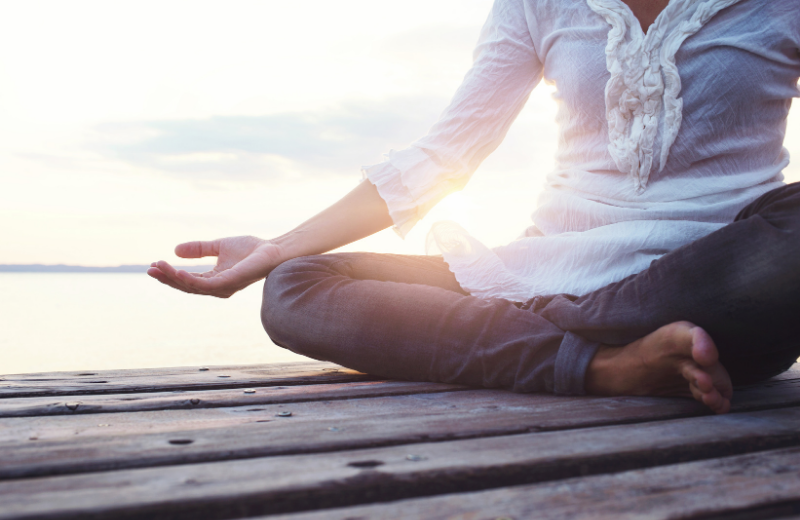Raise self-awareness and connect with your inner self

Amal Karl
CEO
Awareness is knowledge of one’s self and surroundings. Self-awareness is the ability to see ourselves clearly and objectively through reflection and introspection. Research shows that self-awareness has a direct impact on how we think, feel, act, as well as how we react to our thoughts, feelings and actions. If we have the conscious knowledge of our own character, feelings, motives and desires, then this level of internal understanding may just be the most powerful tool we can have in our life.
One of the drawbacks of living in our hectic, fast-paced society that equates external achievement with self-worth, is that we lack connection with our own bodies and have lost touch with our inner self. Many of us wouldn’t have a clue who we are – our inner self remains hidden behind an outer facade we create, an effort that is externally directed. Yogic science offers us a systematic approach to truly internalise and be connected with ourselves.
Think about it, has our gut feeling ever really been wrong? When our self-awareness game is strong, we know it’s our best bet to trust what our intuition is telling us about decisions, situations and people.

Why should we raise our self-awareness?
Increased self-awareness has the potential to enhance virtually every experience we have, as it’s a tool and a practice that can be used anywhere, anytime, to ground ourselves in the moment and, realistically evaluate any situation. There are well-researched benefits to the practice of self-awareness:
- It can make us more proactive, boost our acceptance, and encourage positive self-development (Sutton, 2016).
- It allows us to see things from the perspective of others, practice self-control, work creatively and productively, and experience pride in ourselves and our work as well as general self-esteem (Silvia & O’Brien, 2004).
- It leads to better decision-making (Ridley, Schutz, Glanz, & Weinstein, 1992).
- It can make us better at our jobs, better communicators in the workplace, and enhance our self-confidence and job-related wellbeing (Sutton, Williams, & Allinson, 2015).
Albert Einstein said “The intuitive mind is a sacred gift and the rational mind is a faithful servant. We have created a society that honours the servant and has forgotten the gift.” Our intuition is that gut feeling that tells us if we are on the right track. Think about it, has our gut feeling ever really been wrong? When our self-awareness game is strong, we know it’s our best bet to trust what our intuition is telling us about decisions, situations and people.
According to renowned psychologist and author Daniel Goleman, self-awareness is also a necessary building block for emotional intelligence.
How do we inculcate self-awareness in our lives?
An article in The Harvard Business Review noted that only 10–15% of the people studied display self-awareness, although most of us believe we are self-aware (Eurich, 2018). The Sanskrit word svadhyaya “self-study,” like many, has a richer history than cannot easily be captured in English. The first part of the word – sva – meaning own, self. The second part – dhyaya means ‘to study, to contemplate, to think on, to call to mind’. Thus, it translates as ‘to study one’s own self’. In the ancient Vedic scriptures, self-study is considered an inherent part of our learning, and is quoted as, “Yoga is the journey of the self, through the self, to the Self”.
In many pieces of writing regarding the practice of yoga, when we see the word self, written with small ‘s’, it refers to ourselves in this physical form, our ego, and who we consider ourselves to be on a daily basis. When we read the word ‘Self’ with a capital ‘S’, this refers to the true self, Atman, or the Divine, Eternal Consciousness within all of us. The small ‘self’ is mostly concerned with survival, which usually entails getting what it wants in all situations. It judges, criticises, fears, conditions, doubts and is essentially the cause of the ‘chitta vrittis’, or ‘fluctuations of the mind’. By paying attention to, or studying our ‘self’, we become more aware of the things that hinder our thinking and also those which serve us and bring us closer to that process of ‘uniting’ with the true Self.
Lao Tzu summarises this to perfection in his quote: “Watch your thoughts, they become words; watch your words, they become actions; watch your actions, they become habits; watch your habits, they become character; watch your character, for it becomes your destiny”.
Lao Tzu

Improving our self-awareness with the SWAN method
Just as we use SWOT analysis (Strengths, Weaknesses, Opportunities & Threats) within our businesses, we can use SWAN analysis (Strengths, Weaknesses, Aspirations & Needs) to gain a better understanding and acceptance of ourselves. To understand and to discriminate between our strengths, weaknesses, aspirations and needs, gives us empowerment.
We may not think about these qualities, yet at every moment they are active in our lives and dictate who we are. If we don’t understand ourselves at a deeper level, then what is the quality of our existence? If we wish to direct, control and guide the subtle expressions of our personality, awareness has to be extended into these areas.
These strengths and weaknesses are physical, mental or spiritual. The strengths can be willpower, compassion or anything that can be applied positively and constructively in life, traits which help us evolve and grow. Weaknesses can be a lack of mental clarity, tension, and other such traits which sometimes overshadow the strengths or positive aspects of our life. The challenge, therefore, is to improve the awareness of our strengths, as these can be applied constructively to overcome our weaknesses, which unfortunately we rarely do. We need to accept our shortcomings and take the time to learn from them rather than dwell on them. Our aspirations and ambitions may be external in relation to family, society, fame and status. How can we shift these to become more internal, such as wanting to be a more compassionate person? We also have our needs, which are physical, emotional (e.g., relationships), mental (e.g., satisfaction) and spiritual. We can reflect on how can we reduce our material needs to make our life simpler?
If we don’t understand ourselves at a deeper level, then what is the quality of our existence?
If we wish to direct, control and guide the subtle expressions of our personality, awareness has to be extended into these areas.
Perhaps it’s time to dig a little deeper into the underpinnings of yoga – Svadhyaya, in the sense of studying ourselves in daily life. This involves taking our yoga practice off the mat, and exploring the nature of yoga itself.
SWAN Meditation Practice
Sit comfortably in a meditation position, keeping spine, head, neck, shoulders straight and in alignment. Gently close your eyes.
Then, become aware of your whole physical body from head to toe. Allow the entire body to relax in this position. Become aware of the natural breath, settle into a rhythmic breath and feel the whole body becoming calm and still.
As you hone in to the space directly in front of your closed eyes, bring your focus to one aspect of SWAN (say, strength), and pay attention to the top 3–5 attributes that come to you easily of their own accord.
Similarly, become aware of the top 3–5 strengths that you want to develop. Continue in the same zone and try not to think of any one particular trait. Is there a strength that comes to your mind?
If yes, this will be your best strength. If nothing comes to mind, let it be, it may come in a subsequent reflective session.
Now move on to visualising a small, steady, brightly burning candle flame just in front of your closed eyes, and chant the mantra ‘Om’, or a mantra of your choice three times. Now slowly come back into the physical space and body. Move your fingers, stretch the body, release the posture and open your eyes.Carry on this practice to visualise your weaknesses, aspirations and needs.
Meditation is the first step to identify our SWAN, followed by self-reflection. We may find that as our minds are restless, we move from one of our SWAN traits into the next at an incredible pace, so fast that we are unable to differentiate between our strengths, weaknesses, aspirations or needs. Life is full of trials, and yoga is a lifelong learning process about ourselves, so we need to go slow and fully assimilate one aspect of our personality to derive benefit from this process.
As a Sadhana (discipline or dedicated practice) for one month, pick up only ONE strength and cultivate it to the maximum, or focus in a month to overcome only one weakness. Use these monthly reflective sessions to also update your SWAN attributes as you will continuously gain better personal insights. (A pdf copy of the complete step by step SWAN practice can be sent upon request).
As Swami Niranjananada aptly summarises, ‘Ultimately, through the practices of SWAN meditation, a stage of integration is reached wherein the different levels of the personality – instinctive, emotional, mental and psychic, are able to function and coordinate harmoniously. The fragmented aspects of the human personality, which hinder and limit creative potential, are gradually unified and reinforced, creating more positive channels of expression.’
When it comes to designing a yoga practice, it’s easier to picture doing seated forward bends and downward dogs than engaging with the Yamas (Restraints) and Niyamas (Observances) – these being the first two rungs on the ladder of classical yoga. Postures fit into a daily schedule and have beginnings, middles and ends. But yogic attitudes such as cultivating positivity and contentment are more contemplative in nature and require a measure of truthful self-examination. As a result, they tend to fall off our practice map.
Perhaps it’s time to dig a little deeper into the underpinnings of yoga – Svadhyaya, in the sense of studying ourselves in daily life. This involves taking our yoga practice off the mat, and exploring the nature of yoga itself.
Share:
Related Posts

End of Year Reflection: Breaking the Cycle and Living with Intention
As the year draws to a close, I find myself in that familiar pause between what has been and what is yet to come –

Sonder – so much more than a poetic idea
I wasn’t looking for inspiration, but it found me anyway! On a recent weekend in Raglan, my eyes lingered on a whimsical painting by a

Establishing Our Inner Connection
Swadhyaya, from the Sanskrit sva (self) and adhyaya (study), refers to the disciplined practice of self-inquiry. Rooted in Indian spiritual traditions, it involves reflection, scriptural

Navigating Life’s Uncertainties: The Power of Acceptance and Positive Action
Life is full of unpredictable events, people, and circumstances beyond our control. From the weather to others’ behaviour, uncertainty is constant. However, our response to

The End of Ego: Reclaiming Inner Peace
In today’s fast-paced world, we often blame external factors – bad luck, challenging situations, or difficult relationships – for our biggest obstacles. Yet, the real enemy is
